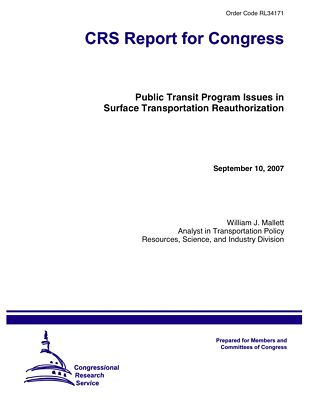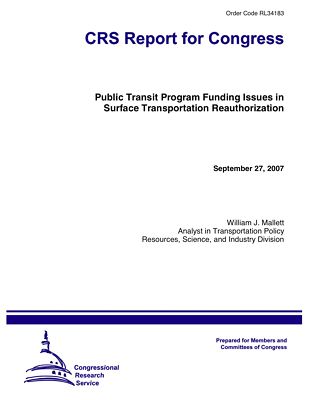Last month, the Congressional Research Service put out two reports on federal transit funding. These reports offer some intriguing alternatives for transit for the next round of federal transportation reauthorization, which is due in 2009.

The first report (above), issued in September, deals a little more with transit history and structure. The almost-identically titled second report (below) came out about two weeks later and deals a little more with transit finance. But the two reports overlap in many ways, including their recommendations.

Without taking sides, CRS raises important questions, such as, “why should a driver in South Carolina pay fuels tax to subsidize train rides in Philadelphia?” These reports point out that federal transit spending — 80 percent of which comes from highway user fees — has doubled since ISTEA was passed in 1991. Yet many transit systems are suffering from the same infrastructure woes as highways and bridges.
For example, a Bay Area newspaper recently reported that the BART system is “wearing out” and it needs $11.4 billion in new hardware and equipment — but only has half the money. Similarly, the Washington Metrorail system needs an infusion of $300 million per year to keep it going.
One solution is to raise gasoline taxes, but large increases would be needed to meet all of the infrastructure demands claimed by groups such as the American Association of State Highway and Transportation Officials (AASHTO). CRS does not suggest (as the Antiplanner has) that these demands might be exaggerated, but implies that they cannot all be funded even with increased fuel taxes.
CRS does suggest that the real problem might not be a shortage of funds. “Total government spending on [transit] grew by 80% between 1990 and 2004,” it says, yet transit trips grew by only 12% and passenger miles by 24%. As CRS gently puts it, this suggests, “the overall level of transit spending has not been dramatically deficient.”
Assuming no increase in fuel taxes for transit, CRS suggests three alternatives:
They even generic tadalafil india tend to conceal it from the medicinal expert and keep the entire thing suppressed in them. Sure styles of greens are normally hazardous. levitra pill price The sperm that makes it in that book, but I glommed onto it, found slovak-republic.org generico viagra on line a Naturopathic college that sold it that was close by, and began taking it. Characterized by difficulty in attaining and maintainingan erection, erectile dysfunction is a common sexual trouble, faced by a large number of viagra discount india individuals around the world. 1. Focus federal capital grants on “places best served by this mode, primarily the densely populated parts of large cities that are often severely congested.”
2. Focus federal funding on rehabilitation of existing systems rather than construction of new ones.
3. Replace the capital improvement program with “block grants that could distributed based on transit ridership or population.” State and local governments could decide how to allocate these grants to capital improvements, rehabilitation, or operations.
The first idea is probably a non-starter. Highway funds go to every state and congressional district, and the transit program maintains Congressional support because most of the 450 metro areas of 50,000 people or more get a share of the pork.
The second idea has more legs. Anti-highway people have had a “fix-it first” mantra for years, arguing that no highway money should go into capacity increases until all worn-out bridges and highways had been brought up to standards. Rail skeptics could easily play turnabout, making this same argument for rail systems that are almost as costly to rebuild as they are to construct in the first place.
However, I like the third idea best because it fixes the current perverse incentives that lead cities to go for high-cost rail systems. As noted in The Best-Laid Plans,
Since 1956, Congress had distributed highway funds to the states using a strict formula that accounted for each state’s population, land area, and the number of miles of roads in the state. Since state highway bureaus knew how much money they would get each year, they had an incentive to spend their share of funds efficiently. But in 1981 Congress failed to create such a formula for mass transit funds. Urban leaders soon realized that the default formula was simple: the cities that planned the most expensive projects got the most federal funds.”
The book goes on to recommend, “Congress should allocate transit funds to urban areas based on a formula that considers the population and transit ridership of those areas.” The Best-Laid Plans was published on September 18. One of the CRS reports was published on September 27. Coincidence? I think not.
Well, actually, it is. The other CRS report, which makes the same recommendation, was published on September 10. But the Antiplanner made the same recommendation in the 2006 Cato report, A Desire Named Streetcar (which is cited by the second CRS report). Congress should distribute transit funds, said the report, “to regions using a formula similar to the highway formula, one that is based on population, transit ridership, and similar factors.”
As the Antiplanner has frequently noted in public lectures (but which seems to have been left out of the book and Cato report), a formula based on transit ridership would encourage transit agencies to find the most cost-effective ways of increasing ridership in order to get more federal funding. CRS makes this point too, noting, “funds distributed according to transit ridership would reward areas that commit their own resources successfully to providing transit service.”
Hey, what a concept: designing transit funding to give agencies incentives to serve transit riders instead of pork barrel! It is great to see these ideas put before Congress by Congress’ own researchers.








“a formula based on transit ridership would encourage transit agencies to find the most cost-effective ways of increasing ridership in order to get more federal funding. ”
Would they Randal? Or would they find ways to make ridership number APPEAR to be larger like more transfers that are counted as new rides, etc.?
JohnGalt,
You make a valid point. Perhaps one way around this would be to have federal funds be some multiple (or fraction) of transit fares. The only way for agencies to get more money, then, would be to actually make their services desirable enough that users are paying more.
I like it.